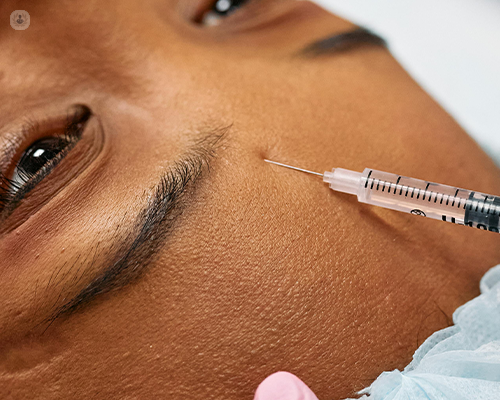The power and limitations of Botox
Written in association with:Botox, short for botulinum toxin, was originally invented to help correct a lazy eye, but now is best known for its application as a non-invasive cosmetic anti-ageing treatment. In this article, a consultant dermatologist explains the ways that Botox can be used, and the potential risks or downfalls.

What is Botox?
Botox is a neurotoxin that, when injected, paralyse and relax the muscles, freezing them temporarily and leaving the skin without the fine lines or creases that are caused by muscular tension. The neurotoxin inhibits the production of acetylcholine, which is a neurotransmitter that transmits between nerves and muscles the signals that tell the muscles to contract or tense.
The injections are done with ultrafine needles, in meticulously mapped spots for the best results and to avoid nerve damage – however, there may be numbness or pain in and around the injection sites, but this will only last for a few days at most. Upon request, the injection sites can be topically numbed before the procedure.
How is Botox used?
It is most commonly done in the frown lines between the brows where they furrow, forehead lines from when the brows are raised, and crow’s feet around the eyes from smiling, but Botox can be injected virtually anywhere where there are wrinkles, fine lines, or any looseness in the skin:
- The jaw and chin to release tension and correct downturn smiles or chin dimples and alleviate tension pain
- The cheeks to relieve pressure on the muscles there, the masseter muscles
- Around the lips to reduce puckering when the lips are pressed together
- In the upper lip to reduce the visibility of the gums of a ‘gummy smile’
- In the neck along the platysma muscle to address jowls and a saggy neck, or to help neck spasms (cervical dystonia)
- In the underarms to help prevent excessive sweating (hyperhidrosis)
What happens after Botox?
The results will start to show after around three days, not immediately after the procedure, lasting up to eight months, so there will have to be repeated applications to maintain the results. However, it is preferable to other cosmetic procedures as it only takes around 30 minutes in a session, there are no incisions, and the aftercare is very simple; patients can resume their normal day right after the session and can go straight back into their grooming and makeup routines – however, they should avoid exercise and strenuous activities and should not put too much pressure on the injection site for a day.
Botox disclaimers
Botox should always be applied by an accredited, professional doctor or specialist. In the wrong hands, Botox incorrectly injected can cause asymmetrical results – such as droopiness, crooked smiles and brows – nerve damage, loss of facial expression, infection at the injection site, slurred speech and drooling, and headache and flu symptoms. Some patients may be allergic to the botulinum toxin and can have a bad reaction to the injections with itchiness, hives, and redness. Pregnant or breastfeeding people cannot have Botox for any reason, medical or cosmetic.
It is a temporary procedure that can be touched-up, but Botox cannot permanently stop the ageing process and cannot reverse the effects of time on the body.
If you would like to know more about Botox and its benefits, consult with a specialist via Top Doctors.


